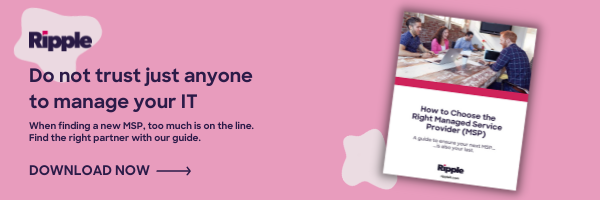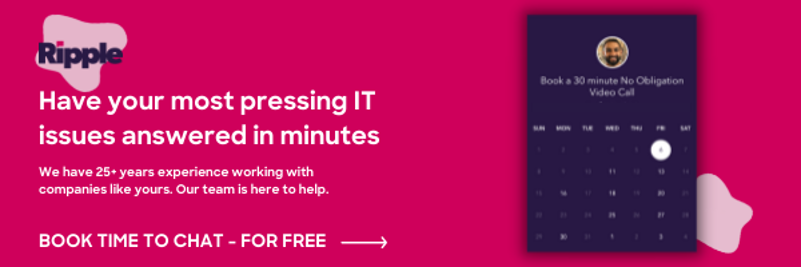
The success of an organization-wide IT project like email migration or multi-factor authentication are critical to you and your organization. If everything goes smoothly, life goes on with minimum fuss. However if the project goes sideways the fallout could lead to tough conversations and tougher decisions.
You do not need to get to that point!
In this post we will work through three time tested components that when properly used in a project will lead to successful outcomes. Before heading into your next big project, make sure your IT partner has these aspects in place.
Looking to switch IT partners?
What Constitutes a Successfully Executed IT Project?
Which of the below will reflect the best on you and ultimately help your organization win?
Completing the project in a timely fashion;
- While managing your expectations.
- With full organizational expectation setting.
- With full organizational expectation setting and user education.
You might notice there is no mention of everyone being happy or users not complaining. In our experience this rarely if ever happens, especially for larger projects. Change is hard. No matter how much diligence your IT partner shows, it is very hard to take the human element of anxiety completely out of a major project.
If you make sure your next project has the following three components you can largely help mitigate the human factors that derail projects.
Dedicated IT Project Resources
Dedicated project resources are often overlooked in IT Projects. The critical resources to project execution are the engineers doing the project, and the project manager leading the project.
Many times the technical person and IT project manager are the same person. In addition they have responsibilities that fall outside of the project, like day to day support for your users. You might think a single person who knows you well would cut down on the miscommunication and scheduling snafus that can occur on a team. Let’s look at 3 examples of why this doesn’t work.
1. Technical blind-spots affect communication
When a single resource supports you they are technically knowledgeable when it comes to your organization, but with that technical greatness they make assumptions that you and your team don’t share. This is why when serving as a project manager for their own projects the communication suffers. The engineer is thinking: “they should know that…” which creates gaps in what is being communicated. This leads to confusion and adds to overall team frustration with the project.
2. Managing IT project resources
Managing people and schedules is hard. Doing that and executing a complex project is close to impossible. When the PM and project engineer are the same person it hurts the ability to delegate and/or follow up with the resources brought into the project.
3. Support after completion of the project
Many projects require some critical work to be done while users are not working. In most cases this is on the weekend, which makes Monday morning the first time your users experience the changes. That single resource that is supporting you and implementing the project (and managing the project!) worked all weekend (maybe all night on Sunday night). When the calls start rolling in Monday morning, this single person is tired, overworked, and not ready to help patiently navigate your teammates through a new system. This will have a negative impact on the user support, and your teams overall feeling about the project. No matter how technically superior the new system is, it will not be seen as a success.
Key Takeaways:
- Your project should be managed by a dedicated project manager who is not responsible for the technical part of the project. Their role should not have emergency technical responsibilities that will take away from their management and documentation tasks.
- Have a dedicated project engineer whose main focus is executing projects and not support.
- Have dedicated support resources whose main focus is support and not executing projects.
A Communicated Communication Plan
Another important piece of consistent project execution is communication. Use a documented and communicated communication plan. Ironically, many Communication Plans are never actually communicated. This should meet your teammates where they are most comfortable, through multiple mediums like emails, project management software alerts, and phone calls.
A documented communication plan goes beyond just making sure you hear from your IT service provider during the project. For example, a good communication plan should:
1. Keep the IT project top of mind for both you and your IT service provider
Do you like to procrastinate? Would you enjoy procrastinating as much if you had to communicate your progress frequently? Communication when done right is a strong motivator, especially for the hero-style personalities you will find in IT.
2. Keep your users in the know
Procrastination from your IT provider will frustrate you, but that goes double for your users. A good communication plan will reach out to your teammates to set their expectations multiple times. The information may be redundant, but having people understand what is happening, when it is happening, and how exactly they will be affected pays big dividends when a project is being executed.
3. Manage expectations – yours and your team's
No matter how well the IT partner communicates with your team, you are going to need to assist. Scheduled communication gets you answers. This goes a long way towards keeping you out in front of the questions internally, and it allows you to better manage users you know are more averse to change.
4. Minimize items falling through the cracks
A scheduled chat does wonders to jog the memory for both you and your IT partner. Mostly because all parties involved tend to “get ready” for a call. This process allows everyone some dedicated time to think about the project which typically results in remembering items they forgot to communicate or document.
Key Takeaway:
- Ask for a communication plan that is specific, written, and includes multiple communication mediums to connect with more people.
- Make sure end user communication is included in the plan and repeatable.
User Education
Change is hard. You can manage the disruption a large project creates for your users with user education. The more comfortable people are with the changes and what to expect, the easier project adoption is.
IT services companies often leave out this important aspect. You should not accept this. What good are tools if your users cannot use them or are not comfortable using them? What good is a completed project if all of your users are frustrated? Focus on effective education with 2 very specific things, materials and content.
1. Materials – get education out to the users
People learn in a variety of ways so we suggest multiple materials including:
- Written instructions
- Recorded video
- Live Q/A
An effective mix of materials will allow your teammates to educate themselves in the manner they find most effective.
2. Content – pay attention to what your users are learning
The most effective teaching comes in the form of standard day to day workflows.
For example, in Microsoft Teams you may show users how to create a channel for a specific project. To be effective the training should include:
- Channel creation with proper naming technique
- Adding users to the channel – internal and external
- Sharing files by leveraging cloud file sharing (e.g. OneDrive, Sharepoint, Egnyte, etc…)
- Pinning posts in channel – workarounds for the ability to pin conversations/posts to channels.
Your IT service provider should be able to bring their experience and familiarity to bear in educating your users. Daily workflows and workarounds are key nuggets your users will snap up when given the opportunity.
Key Takeaways:
- A well executed education plan will help user adoption.
- Use multiple mediums to account for user learning styles.
- Make sure training is real world workflows to increase user comprehension.
When it comes to IT projects that impact your entire organization, the success criteria must be more than just getting the project done. IT service providers with the ability to manage resources, communication, and education will effectively give your organization the best chance to succeed. Want direct access to talk to an expert? Book some time with our team today.
Ripple's IT Team
Don't Fall Behind!
Get the latest work-from-home and Humans First® IT tips straight to your inbox.

